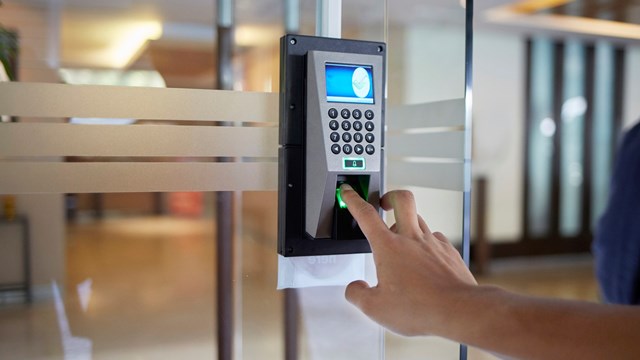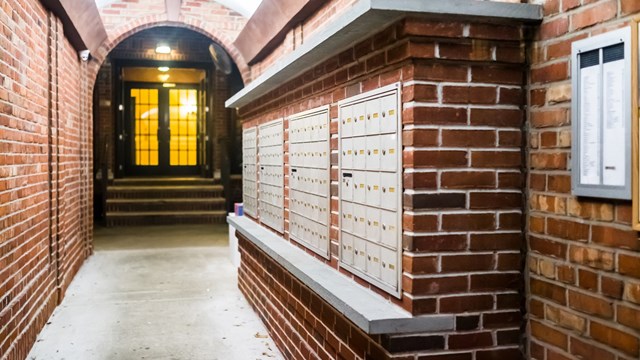
Recent nationwide crime statistics show that New York City and its outlying suburbs has become one of the safest cities of its size in the past 15 years. Nevertheless, in a sprawling metropolitan area encompassing New York and New Jersey, security is always a concern.
“People are either interested in security or they’re not. There are plenty of options out there for a condo or co-op to better protect their building,” says Harry Squasoni, senior vice president of American Security Systems, based in Long Island City. “Most buildings still have keys, which is the worst security alive. Keys go to girlfriends, boyfriends, contractors…you have no idea who has keys to your building.”
As technology has advanced, security system options for multifamily buildings and homeowner associations have broadened as well. The key is getting boards and management companies to institute the changes.
“There is a fear of change and a fear of technology sometimes,” says Colin Foster, vice president of sales and marketing for Manhattan-based Virtual Doorman. “The biggest hurdle is working through a democratic process. When you are dealing with a board and there are 8 to 10 people making a decision, it can be a long, slow process,” he says. Boards and managers need to do their due diligence to determine what will work best for their building and decide if the security improvements won’t soon become obsolete.
“When management companies select a security system, they should consider one that’s upgradeable, modular and easily fixed,” says Lucien Bohbot, founder and president of Unitone Communications Systems, Inc., a Manhattan company that has been designing, manufacturing and maintaining top-of-the-line video intercom and alarm systems since 1981. “I believe the best option for residential managers and board presidents are systems that give them what they need—and not necessarily all the ‘bells and whistles’,” he says.
However, with technology today evolving so fast, and people ever more connected to their cell phones and text messages, it’s important to have a technically sophisticated product that can handle the needs of this rapidly moving environment.
Watchful Eye
CCTV, which has been around for decades, has taken on an important role in both new construction and existing buildings.
“With advances in software, CCTV cameras can now be viewed remotely by management companies and superintendents in different locations,” Bohbot says. “HD cameras have enhanced picture quality and detection methods and can be integrated with real-time video. We have had situations at Unitone, in which the police have called us asking to review our DVRs in order to help them detect possible robbers.”
Security cameras have improved greatly over the last two decades with the benefits of installing a state-of-the-art security system being that they provide privacy, security and convenience to residents.
“Unitone created the first computer-based residential security system more than 25 years ago, and those systems are still installed in many of our luxury high-rises,” says Bohbot. “Over the years, our systems have evolved to incorporate many upgrades, but the basic system provides residents with a clear picture of arriving guests, on-screen messages, and personal alarms such as intrusion, police or medical.”
Even in this tough economic environment, buildings with top-line security systems are much more attractive to potential buyers. Costs vary, but for a combined video intercom and alarm system, the material cost is about $600 to $800 per apartment, extremely cost effective when you consider the system is running 24/7 and 365 days a year.
The Technical Doorman
The advent of video doorman technology has changed the way that many co-ops and condos run their day-to-day operations when it comes to security, as an off-site concierge accomplishes remotely some of the functions of a real doorman.
“When deliverymen press the button on an outside call panel, they are seen by trained central station operators elsewhere,” Bohbot says. “Through a series of cameras and speakerphones, which are installed in building hallways, the deliverymen are ‘watched’ as they drop off parcels, and eventually leave the premises. It is a great service for buildings that are doormen-free.”
It’s not only deliveries that the video doormen are used for. They also provide residents with a greater sense of safety and security. Since someone is always there if needed, an operator can help someone coming home late get to their door without the fear or trepidation of having someone follow them.
“It’s security with a live interface,” says Larry Dolin, president of Manhattan-based American Security Systems, Inc., which has trademarked the name Video Doorman for its service. “It’s not there to be intrusive. If you don’t want to be bothered, then don’t press the button. But if a young woman is coming back from a date and wants to know that she is safe, the system can monitor her all the way until she gets inside her door.”
The company recently introduced its Safe Lobby surveillance system, targeted at middle and lower income affordable housing.
“It’s interactive and proactive,” says Squasoni. “Research shows that 95 percent of problems start at the point of entry. With Safe Lobby, we have cameras and mikes in the lobby and if someone is loitering, it triggers a connection to our central station and an operator will warn them to leave or we will dispatch the police. People don’t like being filmed and having someone talk to them, so they will generally leave.”
Only in its first year, the system will also trigger contact if someone forces the front door open, if the door is left ajar or if strangers are hanging out in the stairwells.
“There’s also latch-key kid notification,” Squasoni says. “When children come home, they use an access control card and we notify their parents that they are safely home.”
The Video Doorman and/or Safe Lobby systems are perfect for those buildings that can’t afford a doorman, as it costs approximately 10 percent of what operating a 24-hour human doorman service would.
With the Virtual Doorman System, individuals can log into a portal and customize their service based on their own preferences. They are able to put family and friends in the system, set up email alerts for packages and even received text message notification if wanted.
“Virtual Doorman created a new industry 11 years ago because we saw a niche in the security industry where service could increase value,” Foster says. “When FedEx or UPS comes to a building and Bill Smith is not at home, it goes remote to our command center. The UPS person comes up on a video screen and we can have a two-way audio conversation. Once we determine who they are, we would let them in by buzzing the front door, opening the package room door and scanning a signature for manifest release into our custody.”
Beyond packages, the command center can let in personal friends or family members and give access to a digital key safe that will release the key for one apartment. It also offers a personal security guard feature, which will allow a resident to talk to an operator as they walk home to their apartment, with the operator checking the cameras to ensure no one is lurking behind a tree.
A one-time cost ranges from $9,000 to $12,000 for the system with service costs based on a management fee and per apartment fee. That’s still a 90 percent savings over a union doorman, the spokesmen say.
Nothing’s Perfect
A system that runs continually and relies on power and the Internet will have occasional outages or breakdowns and can need repairs. Luckily, most usually aren’t serious and can be quickly fixed.
Sometimes, the video can go down, the audio needs to be louder or a new camera needs to be installed. Maintaining a system is the key to keeping it functioning properly.
“When our repairmen go to buildings that have our systems installed, they don’t just check individual apartments, they check the entire riser system and concierge station, to make sure everything is working properly,” Bohbot says.
With video doorman systems if there’s a blackout and loss of Internet, they will go down. “We can go off-line, but in those rare circumstances, we can fix the problem quickly and the building will still be locked,” Foster says. “Even if you have a regular doorman there are problems. He can be out sick, he can go away for 15 minutes and you have to account for human error.”
Biometric Identification
A security feature just starting to find its way into high-end condos is biometrics, the science and technology of measuring and analyzing biological data. In information technology, biometrics refers to technologies that measure and analyze human body characteristics, such as DNA, fingerprints, eye retinas and irises, voice patterns, facial patterns and hand measurements.
“The newest biometric software uses facial and/or fingerprint recognition, but it isn’t very user-friendly yet in residential buildings because each member of the household has to get his or her fingerprints or face programmed,” says Bohbot. “In an apartment building, card access or key fobs are more user-friendly and can even be easily programmed through the management company or through the video intercom provider.”
To look down the road 50 years is hard to do, but most of our experts don’t see the traditional lock and key going away any time soon.
“No way do I see the key disappearing,” Foster says. “What may happen is that it becomes a good supplement to technology. People will have a key lock door with the ability to backup with technology.”
It is expected that fingerprint biometrics will grow in residential buildings over the next 10 years, but even with that, since every member of a family will have to be fingerprinted, people will likely be concerned with privacy and that could delay implementation of such systems.
“Biometrics may take a greater role in the future but that’s not all that will be used,” Bohbot says. “I predict that more and more buildings will upgrade to include DVR activation, apartment video monitors, on-screen messaging, floor-wide announcements and cell phone text alerts.”
It seems that simple lock and keys will always be around in individual apartments, but even there, many residents will one day want to have their own video intercoms to increase security and provide modern conveniences.
“People want to see their visitors before they are allowed upstairs,” Bohbot says. “They need on-screen messages to alert them they have a package waiting. Many garages have electronic access and electronic gates to homes are commonplace. So the days of only lock and key are long gone.”
Keith Loria is a freelance writer and a frequent contributor to The Cooperator.









Leave a Comment